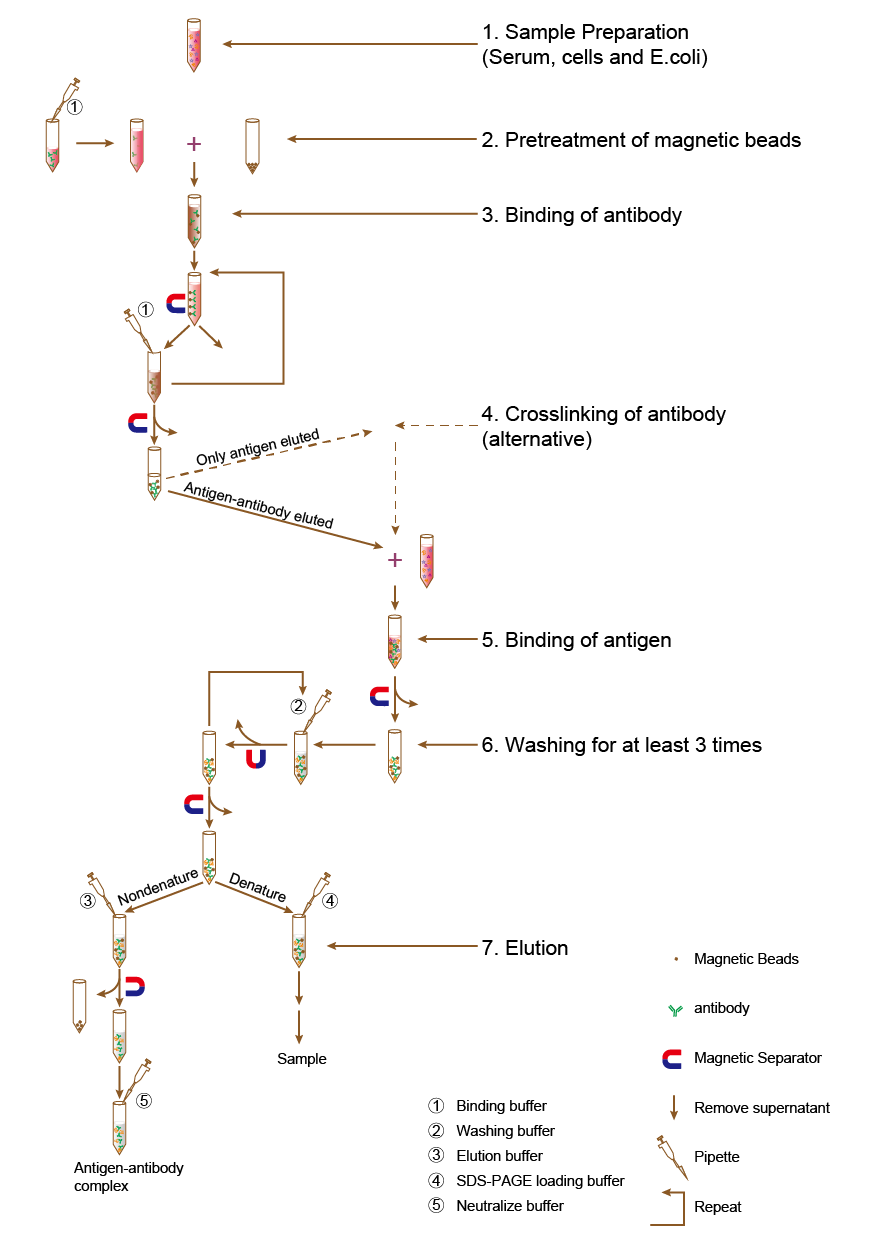Protein A/G Magnetic Beads (IC-8110)
Description
Protein A/G Magnetic Beads for IP use a biological nanosurface technology (S-TEC). Protein A/G is orientated as a coat on the surface of super paramagnetic microspheres with high coating density up to 9.3 ˇÁ 1013 molecules/cm2. Compared to other similar immune magnetic beads, Protein A/G display more antibody binding sites, therefore during IP, less magnetic beads are used. Non-specific binding is low, enabling MagBeads Protein A/G to be used in IP conveniently and efficiently. With a large, specific surface area, these beads can greatly shorten the equilibrium antibody and antigen adsorption time, enabling complete antibody antigen adsorption process within 10 minutes, and complete total purification and precipitation in just 30 minutes. This product can be used on a wide variety of samples, such as in cell lysates, supernatants collected from cell secretion, serum, ascites, and other immune antigens.
Specificity
Protein A/G is a recombinant fusion protein that combines IgG binding domains of both Protein A and Protein G. Protein A/G contains four Fc binding domains from Protein A and two from Protein G, yielding a final mass of 50,460 daltons. The binding of Protein A/G is less pH-dependent than Protein A, but otherwise has the additive properties of Protein A and G. Table1 provides a reference of binding strength between antibodies and protein A/G, use the antibody subtype with strong binding effect in your experiment.
Properties
| Concentration | 10 mg/mL |
| Particle size | 100 nm |
| Binding capacity of human IgG | 0.4-0.5 mg/mL |
| Ligand | Recombinant protein A/G |
| Application | rProtein Purification, Immunoprecipitation |
| pH stability | 6-8 (Long term) |
| Shipped in | Wet ice |
Storage
Store at 4ˇăC for 2 years. DonˇŻt freeze in the absence of glycerol.
Protocol
This procedure (Figure 1) offers a general guideline for immunoprecipitation (IP). Optimization may be required for each antibody and target antigen. Protein A/G Magnetic Beads for IP are ideally suited for IP reactions.

Figure 1 General Protocol for Immunoprecipitation
Recommended buffer examples
Table 2. Recommended buffer examples| Buffer | Contents (Prepared by customers) |
|---|---|
| Binding buffer | 50 mM Tris, 150 mM NaCl, 0.1%-0.5% detergent (TritonX-100, Tween 20 or NP40), pH 7.5 |
| Wash buffer | 50 mM Tris, 150 mM NaCl, 0.1%-0.5% detergent, pH 7.5 |
| Elution buffer |
0.1 M -0.2 M Glycine, 0.1%-0.5% detergent, pH 2.5-3.1 (or 0.1 M citric acid, 0.1%-0.5% detergent, pH 2.5-3.1) |
| Neutralize buffer | 1M Tris, pH8.0 |
Important Notes before Beginning
1 Before immunoprecipitation, please be sure to carefully read the operating instructions.
2 This product requires use of a magnetic separator.
3 Protein A/G Magnetic Beads should be suspended uniformly before use.
4 Protein A/G Magnetic Beads should be kept in storage solution and prevent dry.
5 Do not freeze or centrifuge MagBeads protein A/G.
6 In order to ensure the best results, please select an antibody with strong specificity.
7 For the IP experiments, different antibodies and antigens will display different binding affinities. Antibody and antigen binding may be altered based on use of binding buffer and washing buffer. Some operator optimization may be necessary.
8 This product is only intended to be used as directed. All other uses are prohibited.
| Species | Antibody class | sProtein A/G | sProtein A |
|---|---|---|---|
| Human | Total IgG | Ł«Ł«Ł«Ł«Ł« | Ł«Ł«Ł«Ł«Ł« |
| IgG1, IgG2 | Ł«Ł«Ł«Ł«Ł« | Ł«Ł«Ł«Ł«Ł« | |
| IgG3 | Ł«Ł«Ł«Ł«Ł« | Ł« | |
| IgG4 | Ł«Ł«Ł«Ł«Ł« | Ł«Ł«Ł«Ł«Ł« | |
| IgM | Ł« | Ł« | |
| IgD | Ł | Ł | |
| IgA | Ł« | Ł« | |
| IgA1, IgA2 | Ł« | Ł« | |
| IgE | Ł«Ł«Ł« | Ł«Ł«Ł« | |
| Fab | Ł« | Ł« | |
| ScFv | Ł« | Ł« | |
| Mouse | Total IgG | Ł«Ł«Ł«Ł«Ł« | Ł«Ł«Ł«Ł«Ł« |
| IgM | Ł | Ł | |
| IgG1 | Ł«Ł«Ł« | Ł« | |
| IgG2a | Ł«Ł«Ł« | Ł«Ł«Ł« | |
| IgG2b | Ł«Ł«Ł« | Ł«Ł«Ł« | |
| IgG3 | Ł«Ł«Ł« | Ł«Ł«Ł«Ł«Ł« | |
| Rat | Total IgG | Ł«Ł«Ł« | Ł« |
| IgG 1 | Ł«Ł«Ł« | Ł«Ł«Ł« | |
| IgG2a | Ł«Ł«Ł«Ł«Ł« | Ł«Ł«Ł« | |
| IgG2b | Ł« | Ł«Ł«Ł« | |
| IgG2c | Ł«Ł«Ł«Ł«Ł« | Ł«Ł«Ł« | |
| Cow | Total IgG | Ł«Ł«Ł«Ł«Ł« | Ł« |
| IgG1 | Ł«Ł«Ł«Ł«Ł« | Ł« | |
| IgG2 | Ł«Ł«Ł«Ł«Ł« | Ł«Ł«Ł«Ł«Ł« | |
| Goat | Total IgG | Ł«Ł«Ł«Ł«Ł« | Ł« |
| IgG1 | Ł«Ł«Ł«Ł«Ł« | Ł« | |
| IgG2 | Ł«Ł«Ł«Ł«Ł« | Ł«Ł«Ł«Ł«Ł« | |
| Sheep | Total IgG | Ł«Ł«Ł«Ł«Ł« | Ł« |
| IgG1 | Ł«Ł«Ł«Ł«Ł« | Ł« | |
| IgG2 | Ł«Ł«Ł«Ł«Ł« | Ł«Ł«Ł«Ł«Ł« | |
| Horse | Total IgG | Ł«Ł«Ł«Ł«Ł« | Ł« |
| IgG(ab), IgG(c) | Ł« | Ł | |
| IgG(T) | Ł«Ł«Ł«Ł«Ł« | Ł« | |
| Rabbit | Total IgG | Ł«Ł«Ł«Ł«Ł« | Ł«Ł«Ł«Ł«Ł« |
| Guinea pig | Total IgG | Ł«Ł«Ł«Ł«Ł« | Ł«Ł«Ł«Ł«Ł« |
| Hamster | Total IgG | Ł«Ł«Ł« | Ł«Ł«Ł« |
| Pig | Total IgG | Ł«Ł«Ł«Ł«Ł« | Ł«Ł«Ł«Ł«Ł« |
| Donkey | Total IgG | Ł«Ł«Ł«Ł«Ł« | Ł«Ł«Ł« |
| Cat | Total IgG | Ł«Ł«Ł«Ł«Ł« | Ł«Ł«Ł«Ł«Ł« |
| Dog | Total IgG | Ł«Ł«Ł«Ł«Ł« | Ł«Ł«Ł«Ł«Ł« |
| Monkey | Total IgG | Ł«Ł«Ł«Ł«Ł« | Ł«Ł«Ł«Ł«Ł« |
| Chicken | Total IgG | Ł | Ł |
Notes: ˇ°+ˇ±= weak binding, ˇ°+++ˇ±=medium binding, ˇ°+++++ˇ±=strong binding, ˇ°-ˇ±=no binding
|
Order Information |
|||||
|
Cat./REF. |
Size |
Price($Ł© |
Price(€) |
Price(Ł¤/CNYŁ© |
Price(Ł¤/JYPŁ© |
|
IC-8110 |
1ml |
$97.50 |
€ 117.00 |
Ł¤975.00 |
Ł¤19,402.50 |
|
IC-8110 |
5ml |
$399.00 |
€ 478.80 |
Ł¤3,990.00 |
Ł¤79,401.00 |


